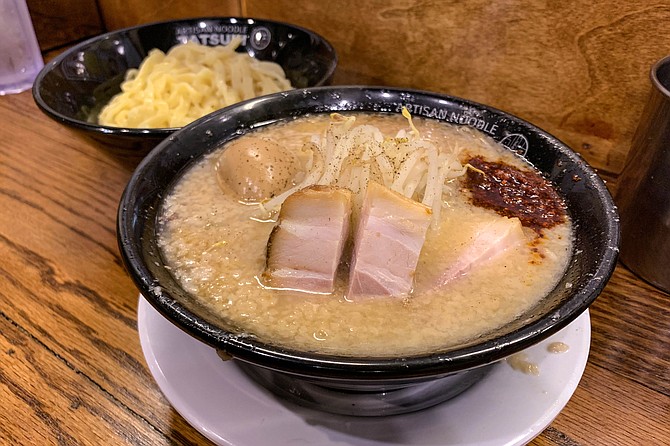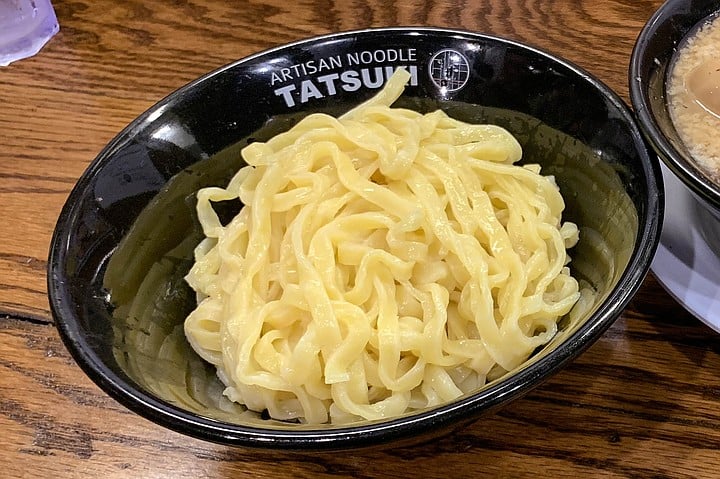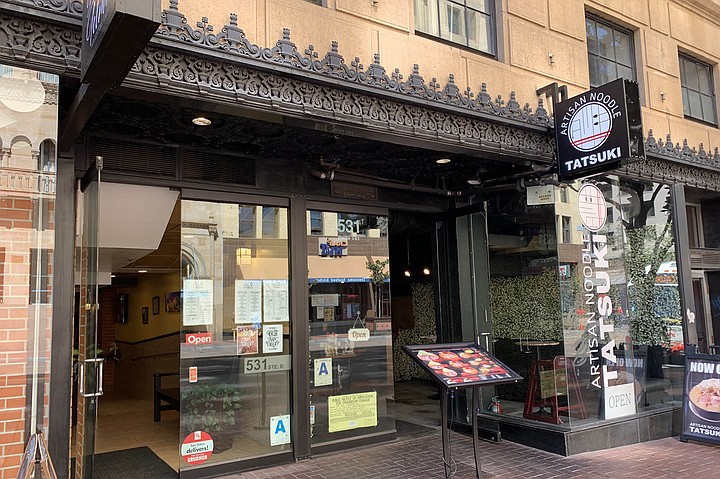 Facebook
Facebook
 X
X
 Instagram
Instagram
 TikTok
TikTok
 Youtube
Youtube

Every time I think my list of San Diego’s top five ramen spots is set, along comes a new one to shake things up. Artisan Noodle Tatsuki opened a few weeks back in the Gaslamp location that was previously home to Ramen Yamadaya. Had you asked me five years ago, I might have called Yamadaya one of our best ramen restaurants, but now this and its original Clairemont Mesa have both closed. I guess that tells us how quickly our ramen market has evolved.
Anyway, back in the Gaslamp, there isn’t much Artisan Noodle Tatsuki could do with the somewhat awkward layout of the ramen bar, which requires you to wait in a small alcove until seating becomes available in a sort of a half basement bar and dining room a short set of stairs below. And already there’s a wait most times, as San Diego ramen enthusiasts do not wait long to check the new noodles in town.

It's tough to go wrong with the simple noodle menu. Bowls come standard with char siu pork, soft boiled egg and char siu pork, or a whole lot of char siu pork. And yes, you definitely need to be a pork fan here, because all the broths are tonkotsu, made from a 60-hour process to render every bit of flavor from pork bones and back fat. This yields a creamy pork broth so rich with tasty fat, you can see it suspended in solution, like the pulp in orange juice. But forget about OJ, and forget about chicken noodle: this is the kind of broth that will stop a cold in its tracks. You can order it served straight, or blended with red miso paste and chili oil for a spicier, more complex broth. Or, you may add provided garlic and chili paste to the standard ramen yourself.

But if you never have, I recommend tackling these noodles tsukemen style. That’s when the noodles are served on the side, where they retain a consistent texture until you dip them into an exceptionally rich broth. Tatsuki put together a handy little comic strip explaining the approach, which is basically to coat the noodles with broth, then slurp away. Daiki Tanaka, the chef behind Tatsuki, put in a few years at L.A.’s renowned ramen spot, Tsujita, where tsukemen is the signature dish. From my times trying Tsujita tsukemen, I recall a little fish essence courtesy of bonita flakes, but if that’s the case in this broth there’s little enough I didn’t notice it past all the ridiculous pork savor.

Going with tsukemen allows those of us who photograph our food to get a clear view of the noodles we’re dealing with at Tatsuki, which do justice to their “artisan” designation. The curly style noodles are wide, like linguini wide, which means more surface area to coat when you dip, which means more flavor without necessarily having to spoon more broth with each slurp of noodles and toppings.
If this leaves you with an excess of broth, you can either order more noodles, or request soup wari, a much lighter broth added to the tonkotsu to thin it out, so you can sip the remainder of that bone broth straight from the bowl. It’s all very Japanese for a local spot, but more importantly it’s made me excited about ramen all over again. Which is good, because even as I write this Tatsuki has just announced the introduction of a white miso ramen, and a miso tsukemen to its menu. I’ll make any excuse to go back.


Every time I think my list of San Diego’s top five ramen spots is set, along comes a new one to shake things up. Artisan Noodle Tatsuki opened a few weeks back in the Gaslamp location that was previously home to Ramen Yamadaya. Had you asked me five years ago, I might have called Yamadaya one of our best ramen restaurants, but now this and its original Clairemont Mesa have both closed. I guess that tells us how quickly our ramen market has evolved.
Anyway, back in the Gaslamp, there isn’t much Artisan Noodle Tatsuki could do with the somewhat awkward layout of the ramen bar, which requires you to wait in a small alcove until seating becomes available in a sort of a half basement bar and dining room a short set of stairs below. And already there’s a wait most times, as San Diego ramen enthusiasts do not wait long to check the new noodles in town.

It's tough to go wrong with the simple noodle menu. Bowls come standard with char siu pork, soft boiled egg and char siu pork, or a whole lot of char siu pork. And yes, you definitely need to be a pork fan here, because all the broths are tonkotsu, made from a 60-hour process to render every bit of flavor from pork bones and back fat. This yields a creamy pork broth so rich with tasty fat, you can see it suspended in solution, like the pulp in orange juice. But forget about OJ, and forget about chicken noodle: this is the kind of broth that will stop a cold in its tracks. You can order it served straight, or blended with red miso paste and chili oil for a spicier, more complex broth. Or, you may add provided garlic and chili paste to the standard ramen yourself.

But if you never have, I recommend tackling these noodles tsukemen style. That’s when the noodles are served on the side, where they retain a consistent texture until you dip them into an exceptionally rich broth. Tatsuki put together a handy little comic strip explaining the approach, which is basically to coat the noodles with broth, then slurp away. Daiki Tanaka, the chef behind Tatsuki, put in a few years at L.A.’s renowned ramen spot, Tsujita, where tsukemen is the signature dish. From my times trying Tsujita tsukemen, I recall a little fish essence courtesy of bonita flakes, but if that’s the case in this broth there’s little enough I didn’t notice it past all the ridiculous pork savor.

Going with tsukemen allows those of us who photograph our food to get a clear view of the noodles we’re dealing with at Tatsuki, which do justice to their “artisan” designation. The curly style noodles are wide, like linguini wide, which means more surface area to coat when you dip, which means more flavor without necessarily having to spoon more broth with each slurp of noodles and toppings.
If this leaves you with an excess of broth, you can either order more noodles, or request soup wari, a much lighter broth added to the tonkotsu to thin it out, so you can sip the remainder of that bone broth straight from the bowl. It’s all very Japanese for a local spot, but more importantly it’s made me excited about ramen all over again. Which is good, because even as I write this Tatsuki has just announced the introduction of a white miso ramen, and a miso tsukemen to its menu. I’ll make any excuse to go back.
Comments